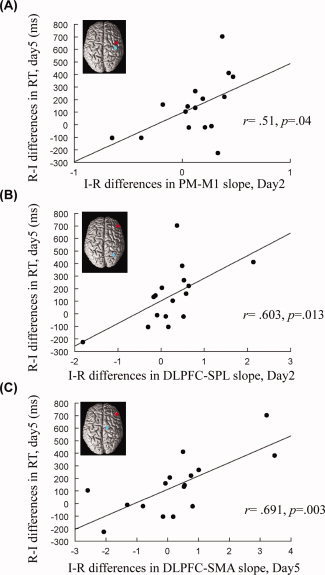Figure 6.

Greater interaction effects of practice conditions are associated with greater learning benefit. The x‐axis indicates the difference in regression slopes of the interleaved minus the repetitive practice condition, for BOLD activities between the ROI pair. Higher x‐values mean a greater interaction effect of the interleaved practice. Learning benefit is represented by the difference in the response time (RT) between the interleaved and the repetitive practices, measured on the retention testing on Day 5 and displayed on the y‐axis. Here, we used the difference in RT of the repetitive minus the interleaved practice (note that this is opposed to the “interleaved minus repetitive” difference in the x‐axis), as we already knew that the interleaved practice led to better learning performance (Lin et al., 2011), and preferred the same direction for data in the x‐ and y‐axes. Our results show that greater differences in regression slopes for BOLD activities between the interleaved and repetitive practices, no matter measured during practice (Day 2, A and B) or retention testing (Day 5, C), correlate to greater learning benefit. This also indicates that when one practices sequences in an interleaved order, stronger connectivity within the cortical motor network is required for successful sequence retrieval. PM, dorsal premotor area; M1, primary motor area; DLPFC, dorsolateral prefrontal cortex; SPL, superior parietal area; SMA, supplementary motor area.
